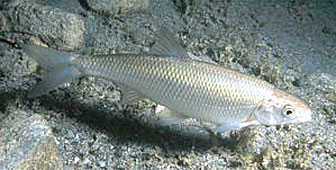
Deformed fish pose mystery for scientists

Around three quarters of all whitefish in Lake Thun, near the capital Bern, have developed deformed sex organs, leaving the Swiss scientific community baffled and local fishermen in a state of shock.
Anglers first discovered fish with multiple ovaries and testicles last winter, and in recent months the number of reported cases has risen dramatically.
The Bern authorities, who have carried out numerous tests on the fish, say the cause of the deformities is so far unknown. They have contacted research institutes around the world in an effort to find answers but have drawn a blank.
Adding to the mystery is the fact that the whitefish is the only species in the lake to have been affected, and the deformities are only confined to Lake Thun.
“We don’t know anything at the moment,” Peter Michel, head of the department of water protection, water supply, and fisheries, told swissinfo. “The reason for this is that these phenomena are not found in other lakes and they came up suddenly in a big percentage.
“We don’t know if they are due to a micropollutant, a chemical pollutant or even a change in the temperature of the water,” Michel said. “We are extending our research around the world to help us find out what’s going on.”
Other theories circulating around Lake Thun are that birth control pills, agricultural pesticides or even munitions buried in the lake could be responsible for the changes in the whitefish.
Fishermen concerned
But while scientists strive to come up with answers, the lake’s fishermen have been left wondering whether their livelihoods are now on the line.
The whitefish is one of the most popular in Switzerland and the biggest source of income for Swiss fishermen. Some 200 to 250 tonnes of whitefish are landed in canton Bern every year, with 50 tonnes caught in Lake Thun alone.
The head of the canton’s fisheries inspectorate, Christoph Küng, said it was too early to say whether the capacity of the fish to reproduce has been affected. But he warned that an adverse effect on the stock of whitefish in the lake and on the size of catches could not be ruled out.
The fisheries inspectorate, which has been examining samples of whitefish from the lake on a monthly basis, said the deformities were not the result of a genetic mutation. Küng said they arose during the development of the sex organs.
According to the inspectorate, there have been no other reported cases of a similar abnormality in other parts of the world.
“At the moment it’s all very much a mystery,” said Michel.
swissinfo with agencies

In compliance with the JTI standards
More: SWI swissinfo.ch certified by the Journalism Trust Initiative





























You can find an overview of ongoing debates with our journalists here . Please join us!
If you want to start a conversation about a topic raised in this article or want to report factual errors, email us at english@swissinfo.ch.